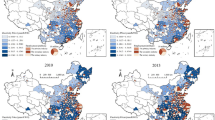Abstract
Average labor productivity in the Thai manufacturing sector is hypothesized to have adverse effect from rising temperature. The study applied Business and Manufacturing Census 2012 and found that 10 out of 12 sub-sectors are statistically significant with an expected negative sign. If Thailand would face with climate change volatility, it is projected that the climate change raises temperature from Baseline scenario by 2.5, 5.5, 6.0, and 7.5%, respectively. Present value of the damage of climate change is estimated to be 95,519 million baht in 2020. The loss has increased to 160,335 million baht in 2050 (in current prices). Damage is expected to be 4.63% in 2020 and 3.95% in 2050 of gross output of manufacture (in 2012 prices), respectively. The government may use fiscal and monetary policy to reshape the cost–benefit of investing in the adaptation of roofing and internal air temperature control. The firm is recommended to implement a medical rehabilitation for affected employees at the firm level to avoid relocation and absenteeism of workers.

(Source: Plot form data on labor productivity index of the Bank of Thailand 2001–2013, and Temperature is from Meteorological Department, https://www.facebook.com/tmd.go.th and Thailand Greenhouse Gas Management Organization (TGO). http://www.tgo.or.th/2015/thai/)
Similar content being viewed by others
Notes
A general circulation model (GCM) is a type of climate model. It employs a mathematical model of the general circulation of a planetary atmosphere or ocean. The model belongs to the Meteorological Research Institute, (MRI), Meteorological Agency Japan. Koonthanakoonwong et al. (2010) had organized a joint research on climate change impact in Thailand with MRI by applying GCM. The prediction scenarios of temperature used in the model are referred in study organized by Limskul (2011). The predicated temperature is again used in this study.
This is unit of temperature measurement at work place.
Official temperature data series is published by the Department of Meteorological comprises maximum temperature and minimum temperature.
This is not inclusive of construction, transportation, banking and finance and agriculture sector.
Average labor productivity in Table 2 based on cross-sectional data is measured in ‘Gross Output per labor’ while the time-series data model is measured in ‘Gross Domestic Product or GDP per labor’.
The National Statistical Office has Business and Manufacturing Industry Survey of 1989, 1999, 2000, 2007 and 2012. The NSO has published only the tabulated data tables. It will be future effort to try the full sample estimation.
It is noted by Stern Review (2007) that climate change could have very serious impacts on growth and development. If no action is taken to reduce emissions, the concentration of greenhouse gases in the atmosphere could reach double its pre-industrial level as early as 2035, virtually committing us to a global average temperature rise of over 2 °C.
References
Asian Development Bank (2009) The economics of climate change in Southeast Asia: a regional review. https://www.adb.org/sites/default/files/publication/29657/economics-climate-change-se-asia.pdf. Accessed 13 Sept 2017
Burke M, Dykema J, Lobell D, Miguel E, Satyanath S (2011) Incorporating climate uncertainty into estimates of climate change impacts, with applications to the US and African agriculture. National Bureau of Economic Research
Hsiao C (2003) Analysis of panel data, 2nd edn. Cambridge University Press, Cambridge
Hübler M, Klepper G, Peterson S (2008) Costs of climate change: the effects of rising temperatures on health and productivity in Germany. Ecol Econ 68(1–2):381–393. https://doi.org/10.1016/j.ecolecon.2008.04.010
Kjellstrom T, Kovats RS, Lloyd SJ, Holt T, Tol RS (2009) The direct impact of climate change on regional labor productivity. Arch Environ Occup Health 64(4):217–227
Koehn E, Brown G (1985) Climatic effects on construction. J Constr Eng Manag 111(2):1985
Koonthanakoonwong S et al. (2010) Collected MRI-GCM data for Thailand. Technical Report. Chulalongkorn University, Thailand
Langkulsen U et al (2010) Health impact of climate change on occupational health and productivity in Thailand. Glob Health Action 3:5607. https://doi.org/10.3402/gha.v3i0.5607
Li X, Chow KH, Zhu Y, Lin Y (2016) Evaluating the impacts of high-temperature outdoor working environments on construction labor productivity in China: a case study of rebar workers. Build Environ 95:42–52
Limskul K (2011) A Master Plan of the Climate Change Impact in Thailand submitted to the National Economic and Social Development Board, Thai government. There 6 supporting reports as follows: (1) Main Climate Model, (2) Regional climate model (MRI_GCM) on precipitation forecast for Thailand, (3) Economic impact of the climate change applying I-O analysis, (4) Energy model, (5) Agriculture impact study (6) Climate impact and adaptation a field survey. The Master Plan was unpublished reports in Thais
Park J (2015) Labor productivity impacts from climate change: Implications for global poverty. World Bank Climate Change and Poverty Conference 2015
Park J (2016) Will we adapt? Temperature shocks, labor productivity, and adaptation to climate change in the United States (1986–2012). Discussion paper 16–81, The Harvard project on climate agreements, Harvard University
Seppänen O, Fisk WJ, Lei Q (2006) Effect of temperature on task performance in an office environment. Ernest Orlando Lawrence Berkeley National Laboratory
Somanathan E et al (2014) The impact of temperature on productivity and labor supply: Evidence from Indian manufacturing. Discussion paper 14-10. Indian Statistical Institute. Delhi Economic and Planning Unit. School of Economics Delhi
Stern N (2007) The economics of climate change: the Stern review. Cambridge University Press, Cambridge. http://www.cambridge.org
Verisk M (2015) Heat stress poses a threat to SE Asia productivity. https://www.maplecroft.com/portfolio/new-analysis/2015/10/28/heat-stress-poses-threat-se-asia-productivity. Accessed 1 May 2017
Author information
Authors and Affiliations
Corresponding author
About this article
Cite this article
Limskul, K. Climate change impact on labor productivity in Thai manufacture. Asia-Pac J Reg Sci 2, 195–209 (2018). https://doi.org/10.1007/s41685-018-0073-5
Received:
Accepted:
Published:
Issue Date:
DOI: https://doi.org/10.1007/s41685-018-0073-5




